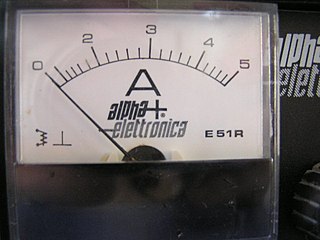
A physical quantity is a property of a material or system that can be quantified by measurement. A physical quantity can be expressed as a value, which is the algebraic multiplication of a numerical value and a unit of measurement. For example, the physical quantity mass, symbol m, can be quantified as m=n kg, where n is the numerical value and kg is the unit symbol. Quantities that are vectors have, besides numerical value and unit, direction or orientation in space.

The International System of Units, internationally known by the abbreviation SI, is the modern form of the metric system and the world's most widely used system of measurement. It is the only system of measurement with official status in nearly every country in the world, employed in science, technology, industry, and everyday commerce. The SI system is coordinated by the International Bureau of Weights and Measures which is abbreviated BIPM from French: Bureau international des poids et mesures.

In photography, exposure is the amount of light per unit area reaching a frame of photographic film or the surface of an electronic image sensor. It is determined by shutter speed, lens f-number, and scene luminance. Exposure is measured in units of lux-seconds, and can be computed from exposure value (EV) and scene luminance in a specified region.
In photometry, luminous intensity is a measure of the wavelength-weighted power emitted by a light source in a particular direction per unit solid angle, based on the luminosity function, a standardized model of the sensitivity of the human eye. The SI unit of luminous intensity is the candela (cd), an SI base unit.
Million years ago, abbreviated as Mya, Myr (megayear) or Ma (megaannum), is a unit of time equal to 1,000,000 years (i.e. 1×106 years), or approximately 31.6 teraseconds.
IEC 60027 is a technical international standard for letter symbols published by the International Electrotechnical Commission (IEC), comprising the following parts:
ISO 31 is a superseded international standard concerning physical quantities, units of measurement, their interrelationships and their presentation. It was revised and replaced by ISO/IEC 80000.
ISO 31-0 is the introductory part of international standard ISO 31 on quantities and units. It provides guidelines for using physical quantities, quantity and unit symbols, and coherent unit systems, especially the SI. It was intended for use in all fields of science and technology and is augmented by more specialized conventions defined in other parts of the ISO 31 standard. ISO 31-0 was withdrawn on 17 November 2009. It is superseded by ISO 80000-1. Other parts of ISO 31 have also been withdrawn and replaced by parts of ISO 80000.
ISO 31-1 is the part of international standard ISO 31 that defines names and symbols for quantities and units related to space and time. It was superseded in 2006 by ISO 80000-3 and again in 2019 by ISO 80000-3:2019.
ISO 31-4 is the part of international standard ISO 31 that defines names and symbols for quantities and units related to heat. It is superseded by ISO 80000-5.
ISO 31-5 is the part of international standard ISO 31 that defines names and symbols for quantities and units related to electricity and magnetism. It is superseded by ISO 80000-6.
ISO 31-6 is the part of international standard ISO 31 that defines names and symbols for quantities and units related to light and related electromagnetic radiations. It is superseded by ISO 80000-7.
ISO 31-7 is the part of international standard ISO 31 that defines names and symbols for quantities and units related to acoustics. It is superseded by ISO 80000-8.
ISO 31-8 is the part of international standard ISO 31 that defines names and symbols for quantities and units related to physical chemistry and molecular physics.

Quantities, Units and Symbols in Physical Chemistry, also known as the Green Book, is a compilation of terms and symbols widely used in the field of physical chemistry. It also includes a table of physical constants, tables listing the properties of elementary particles, chemical elements, and nuclides, and information about conversion factors that are commonly used in physical chemistry. The Green Book is published by the International Union of Pure and Applied Chemistry (IUPAC) and is based on published, citeable sources. Information in the Green Book is synthesized from recommendations made by IUPAC, the International Union of Pure and Applied Physics (IUPAP) and the International Organization for Standardization (ISO), including recommendations listed in the IUPAP Red Book Symbols, Units, Nomenclature and Fundamental Constants in Physics and in the ISO 31 standards.
ISO 31-10 is the part of international standard ISO 31 that defines names and symbols for quantities and units related to nuclear reactions and ionizing radiations. It gives names and symbols for 70 quantities and units. Where appropriate, conversion factors are also given. The standard was withdrawn in 2009 and replaced by ISO 80000-10.

Japanese Industrial Standards (JIS) are the standards used for industrial activities in Japan, coordinated by the Japanese Industrial Standards Committee (JISC) and published by the Japanese Standards Association (JSA). The JISC is composed of many nationwide committees and plays a vital role in standardizing activities across Japan.
ISO/IEC 80000, Quantities and units, is an international standard describing the International System of Quantities (ISQ). It was developed and promulgated jointly by the International Organization for Standardization (ISO) and the International Electrotechnical Commission (IEC). It serves as a style guide for using physical quantities and units of measurement, formulas involving them, and their corresponding units, in scientific and educational documents for worldwide use. The ISO/IEC 80000 family of standards was completed with the publication of the first edition of Part 1 in November 2009.

The International System of Quantities (ISQ) is a standard system of quantities used in physics and in modern science in general. It includes basic quantities such as length and mass and the relationships between those quantities. This system underlies the International System of Units (SI) but does not itself determine the units of measurement used for the quantities.
In science and engineering, a power level and a field level are logarithmic magnitudes of certain quantities referenced to a standard reference value of the same type.







